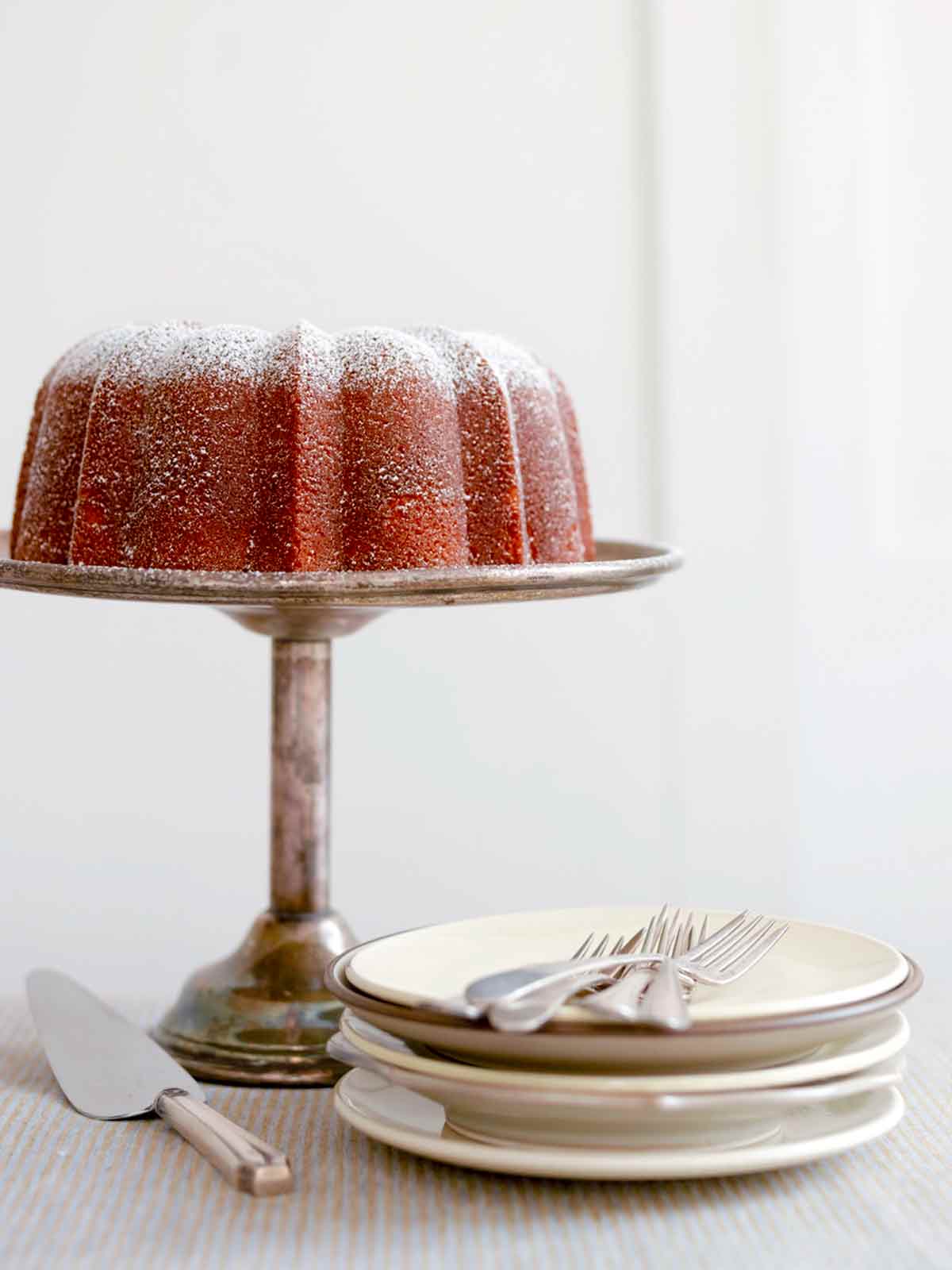
It may not look it, but this orange olive oil cake recipe was, without a doubt, the hardest recipe to develop for my first cookbook, The New Portuguese Table. We made 13 versions of it until I knew it was as good as the recipe I got at Papas, the tiny restaurant up the hill from my apartment in Lisbon. The problem was—and I have no idea if this was intentional—but they gave me a recipe for a classic chiffon cake. Yet their mighty bolo de laranja was dense and rich, and just one slice could satisfy even my appetite.
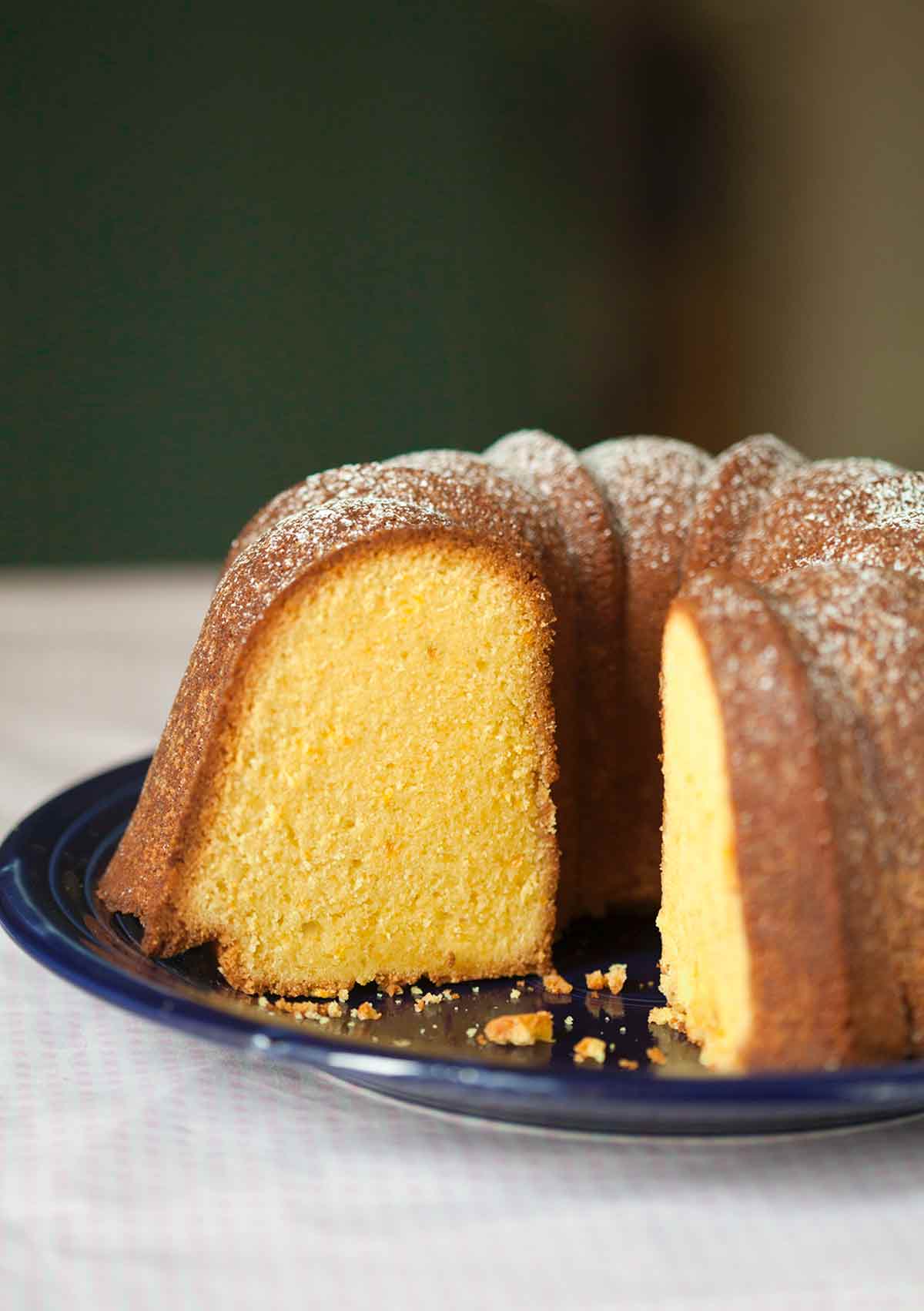
Friend and Portuguese food scholar Janet Boileau was also smitten with Papas’ orange olive oil cake and went to work with me and my recipe tester, Cindi Kruth, trying to figure it out. In the end, it took a call to Lisbon chef Fausto Airioldi to help me get a handle on the dessert. He agreed with me that this was no stinking chiffon cake. It was too full of the bold flavors of Portugal. That’s when Cindi and I started from scratch. Several weeks later, we came up with this cake.


Over the years, I’ve been mightily blessed with all sorts of compliments and accolades for this cake. Some folks have won baking contests with it. One reader used it as the base for her wedding cake. And it’s even featured in a Parisian bakery. (In a smaller, more twee version, naturellement!) But perhaps the compliment I love the most came from 10-year-old Hilton. He’d just woken up and had sat down to breakfast. After a few bites of the cake, he turned to his mother and said…
This is the best thing I ever ate. And I’m already 10!
Hilton
Portuguese Orange Olive Oil Cake FAQs
Considering olives are fruits, all olive oils would technically be “fruity.” But technicalities aside, olive oils can range in flavor from grassy and buttery to peppery and the sought-after fruity. Finer-quality extra-virgin olive oils tend to be perceived as fruity with aromas and notes of tart apple, apricot, pineapple, or banana. There are even olive oils infused with orange. But you don’t need to go crazy trying to find the perfect oil for this cake. Just make sure the one you choose isn’t peppery.
Of course not. But if you want the best possible bite, then, yes, hold your horses. Consider the overnight rest a kind of honeymoon, where the newly-wed flavors have a chance to go from shy and unsure to wildly satisfying. The result? A sexier cake blooming with the blush and aroma of orange.
Video: How to Make This Cake
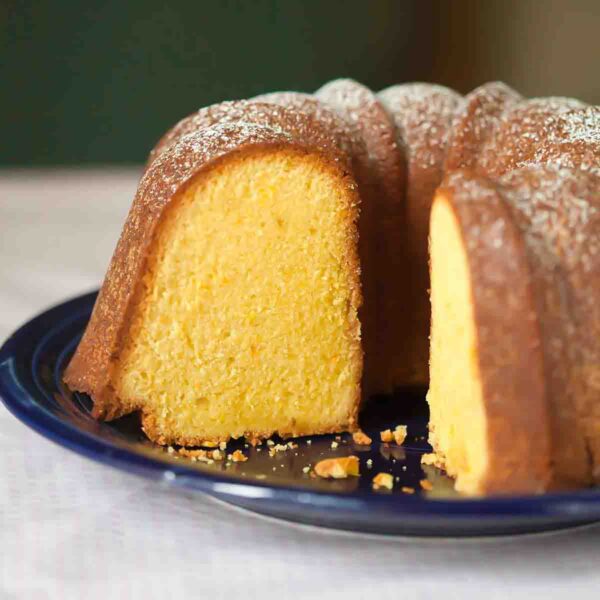
Portuguese Orange Olive Oil Cake
Equipment
- 12-cup Bundt or tube pan (Make sure to use a light-colored Bundt pan. A dark one will turn out a cake that sticks and is unpleasantly brown. The pan I use is Nordic Ware's Anniversary 15-Cup Bundt Pan.)
Ingredients
- Nonstick baking spray with flour
- 4 to 5 large navel oranges
- 3 cups granulated sugar
- 3 1/2 cups all-purpose flour
- 1 1/2 teaspoons baking powder
- 1 3/4 teaspoons kosher salt
- 5 large eggs
- 1 1/2 cups mild, fruity extra-virgin olive oil
- Confectioners' sugar, for sprinkling
Instructions
- Position a rack in the middle of the oven, remove any racks above it, and crank up the heat to 350°F (180°C). Coat a 12-cup Bundt or tube pan with baking spray and set aside.
- Finely grate the zest of 3 oranges into a medium bowl and rub the sugar into it with your fingertips. Set aside.
- Squeeze the juice from 4 oranges. You should have 1 1/2 cups orange juice; if not, squeeze the fifth orange.
- In a large bowl, whisk together the flour, baking powder, and salt.
- In the bowl of a stand mixer fitted with a paddle attachment or with a handheld mixer in a large bowl, beat the eggs on medium-high speed until well combined, about 1 minute. Slowly pour in the orange sugar and continue to beat until thick and pale yellow, about 3 minutes.
- Switch to low speed and alternate adding the flour mixture and the oil, starting and ending with the flour and beating until just a few wisps of flour remain. Slowly drizzle in the orange juice, with the mixer on its lowest setting, to bring the batter together.
- Gently scrape the batter into the prepared pan and bake until a cake tester comes out with a few moist crumbs clinging to it, about 1 1/4 hours. Check the cake occasionally and if the top begins to brown a touch too much, loosely cover it with foil.
- When the cake is done, place the pan on a wire rack and let the cake cool in the pan for 15 minutes. (Don't forget to come back after 15 minutes. Seriously. If the cake remains in the pan too long, the sugars begin to cool and stick to the pan.)
- Turn the cake out onto the wire rack and let it cool completely. (We know. Resist the temptation.) Place the cake on a covered cake stand and let it sit overnight.
☞ TESTER TIP: Seriously. This dense, moist, fruity cake only gets better with age. Don't even think about taking a bite until the day after you make it—or even the day after that.
- Just before serving, dust with confectioners' sugar.

Nutrition
Nutrition information is automatically calculated, so should only be used as an approximation.
Recipe Testers’ Reviews
This orange olive oil cake is an epiphany. It is literally the most fantastic, wondrous creation to ever grace my kitchen. The smell while it’s baking tantalizes, the taste when it’s removed from the oven mesmerizes. Thank you, David, thank you. I cannot wait to make this for everyone I know and let the worshiping begin!
I made the recipe exactly as written. Has anyone tried this with another citrus?
After reading the description of this orange olive oil cake, I couldn’t wait to make this recipe. The cake turned out just as wonderfully delightful as I had imagined. I waited the full 2 days before cutting into it and I’m glad that I did. It’s moist and decadent.
I made this cake for Easter brunch and I was nervous the cake may be too sweet for a few of my guests who don’t eat sweets, so I cut the sugar down to just under 2 1/2 cups with great success. Surprisingly, I could have enjoyed the cake a bit sweeter, and I usually don’t like cakes too sweet, so I imagine the 3 cups would make a perfectly sweet and fabulous cake.
The cake was displayed on our counter in a glass-covered cake dome for about 5 days and it remained moist until it finally completely disappeared.
Here’s the hit of a recent charity bake sale! Easy and a real keeper—the note advising not to cut into the cake on the first day was my first clue how perfect it would be for a bake sale or other need to plan ahead.
I did cut into it on the first day, though, and it was very moist, but not at all in a negative way. It was equally wonderful and perfectly moist on the second day, and I cannot report further, as it was completely devoured on day two—or sold, as it went to a bake sale.
Customers loved the cake and specifically inquired about it. If I make this for a public event again, I’ll attach little tags with a link to the recipe on this site! It’s easy to make and quietly delicious.
I noted the 12-cup Bundt pan specified and divided the recipe into a 9-cup Bundt pan, four mini-Bundts, and a 3-cup “garden bug” Bundt pan that makes five different varieties, including a dragonfly and a ladybug. The bugs were not only charming but tasty. They and the mini Bundts, attractive and impressive, were both standouts at the bake sale for their visual appeal as well as their taste.
The first time I made the cakes, I poured all the batter into these two pans; on my second test batch, I didn’t fill the molds quite as full and made a second set of the bugs in the 3-cup pan. I had no trouble reducing the baking time down for these smaller cakes, and, in fact, the quick bake time for them added to the appeal of this cake. And on top of the delicious flavor and charming Bundt shapes of this sweet orange dessert, it’s a lovely yellow color, sunny, upbeat and attractive.
It took the full 5 oranges to make the required amount of juice. I used a handheld mixer with successful results. After the 15-minute cooling period, the cakes turned out perfectly from the light-colored Bundt pans I used.
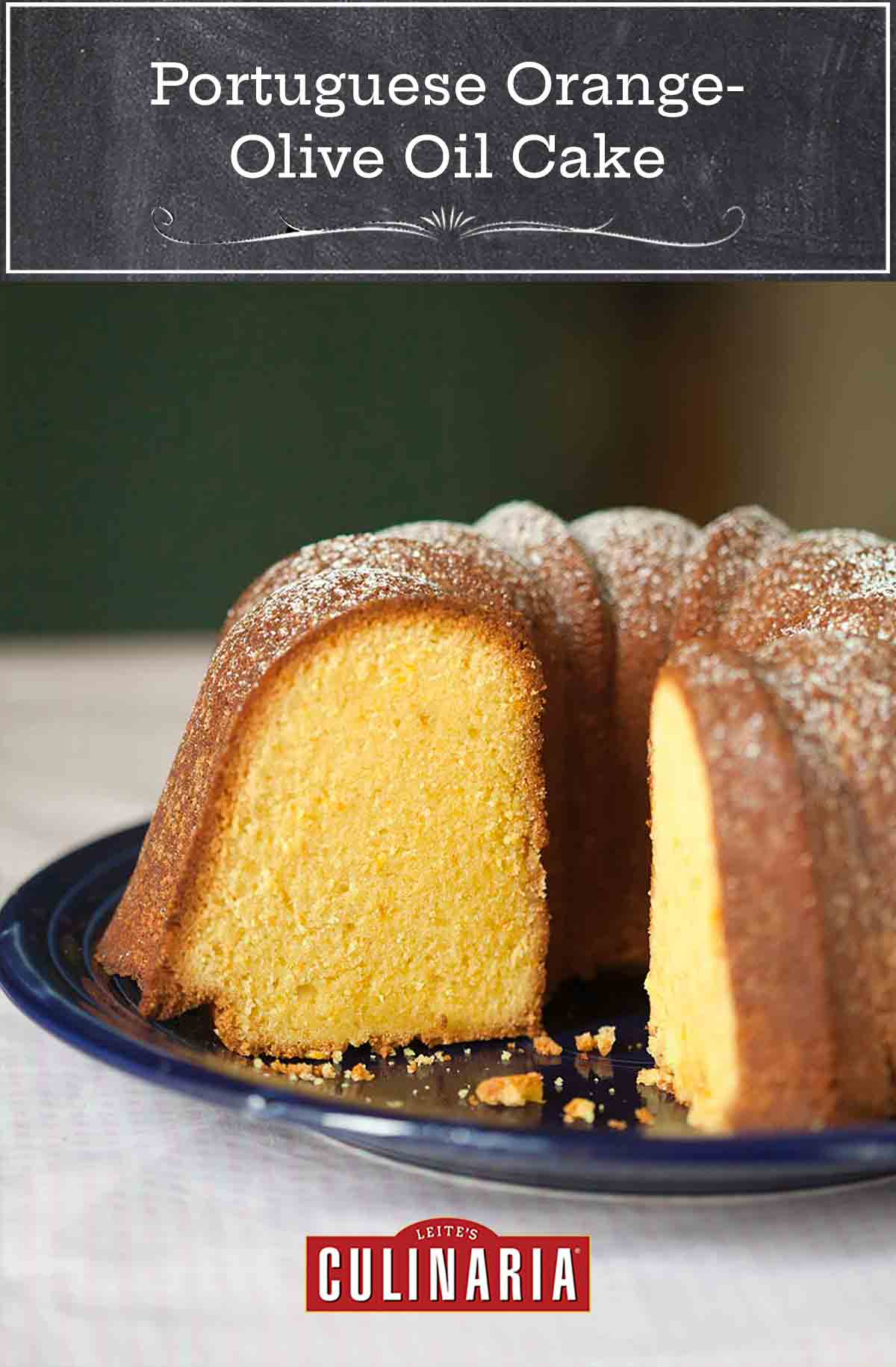



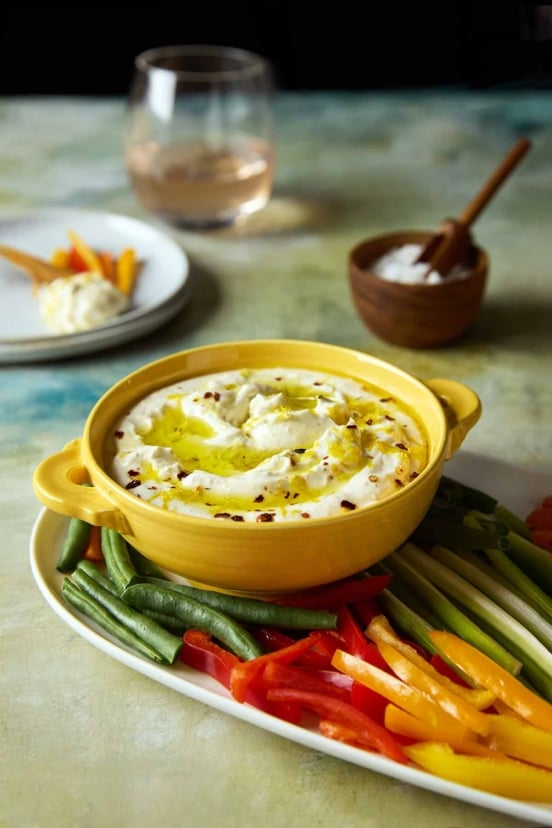
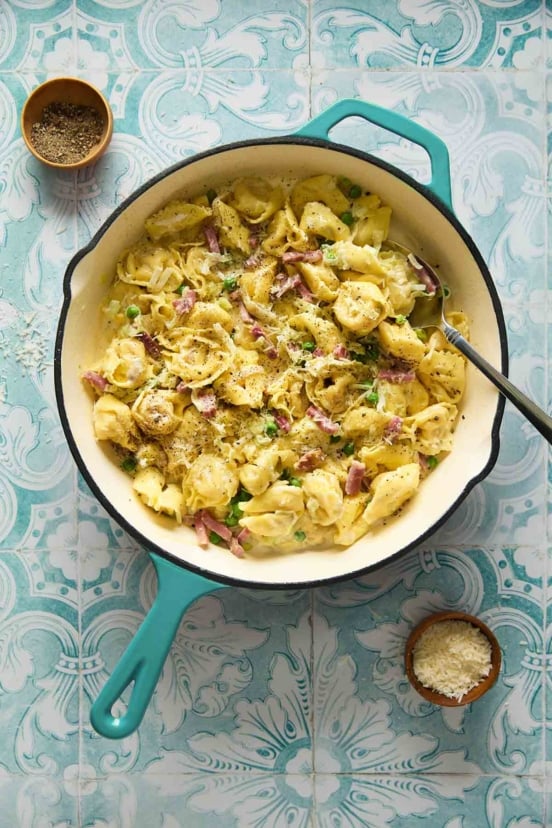
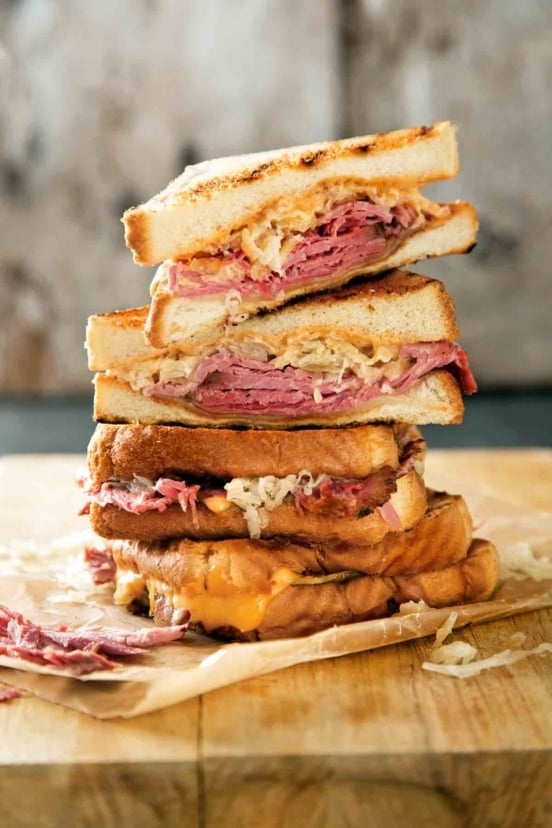









My first ever bundt cake! My first ever olive oil cake! It smelled amazing and came out like a dense pound cake (not sure if that is the correct texture in reality, but still tasted great). Was slightly more oily than my preference (not necessarily in taste, but leaving a lot more oil marks on the napkins than I would like) but that may just be the way of the olive oil cake. This was one of the few recipes I found with a ton of zest and juice, and I loved how a true orange flavor came through. But I was really worried about the method here with adding the juice all at the end after already getting the wet/ dry into a lovely batter. Doesn’t this overmix too much (and hence the denser texture, on the border of being too dense)? Is it possible to mix in the juice earlier in the recipe?
Shana, I’m delighted you like the cake. The texture is exactly as you say: a dense pound cake. Th proportion of oil is pretty standard for Portuguese cakes. Did you eat it right away or did you let it sit for a day or two? And, sure, you can add the orange juice earlier, but it won’t make the texture lighter. It’s definitely a dense cake.
Thanks so much David! We definitely followed your advice and waited two days (it smelled so good right out of the oven it wasn’t an easy feat to wait!). This recipe was the first one of tried of yours but it is definitely a keeper!
Shana, if that is your first Bundt cake, then I have a bakery for you to invest in. That is glorious! Just perfect. Waiting is the hardest part with this cake, but it’s worth it. Wishing you and yours a happy holiday season.
My new go-to cake recipe for keeping EVERYONE thrilled! Everyone who tries it swoons, and it makes the house smell fantastic, to boot.
One caveat: I found the amount of salt overwhelming — it created a salt crust on my cake. I reduced it to 1/2 t. and that works fine. I also suggest coating the (greased) bundt pan with toasted challah bread crumbs before filling with the batter. It makes the cake easier to release and also adds a nice texture to the cake. I also couldn’t resist adding a little Gran Marnier to the orange juice for some added oomph. Other than that — perfection! Thanks! (Also, FYI: this makes a LARGE cake. If you have a small household, it freezes beautifully.)
Lola, thanks. Did you use kosher salt?
Hey, David, I really don’t remember, but it’s quite possible. I guess you’re suggesting that I use table salt instead? Will remember this for future referfence.
Thanks for taking the time to reply!
Lola, no, use kosher. 1 3/4 teaspoons of kosher salt is more than twice that in table salt, which is why it could have been salty for you!
Thanks for the clarification, and thanks for that crazy-good-looking chocolate chip cookie recipe this week — I can never have too many in my repertoire! (BTW, I LOVE the website, and this is one of the very few that made the cut when I culled my e-subscriptions.)
Lola! Thank you. I’m honored that we make the cut. We all try very hard to turn out the best information we can.
The BEST of simple, moist, fruity delicious cakes. I have learned to stock up on the “Zoe” olive oil specifically for this cake. I have made it over a dozen times to lots of request for the recipe. For family and special friends, I have given a copy of the recipe with a small tin of olive oil, so that they can’t go wrong. Thanks for the wonderful stories and recipes!
You are more than welcome, Suzie!